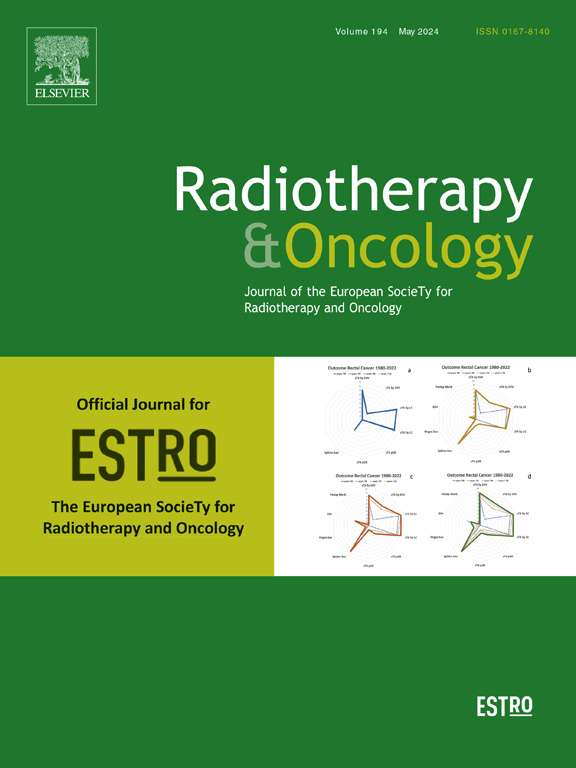Proton beam therapy for mediastinal Hodgkin lymphoma: A prospective study of clinical efficacy and safety
IF 4.9
1区 医学
Q1 ONCOLOGY
引用次数: 0
Abstract
Background
Proton beam therapy using pencil beam scanning is an advanced radiotherapy technique that utilises proton beams to precisely target tumours. It is known for its enhanced ability in sparing healthy tissue and potentially reducing toxicity. Clinical experience with pencil beam scanning in the treatment of mediastinal Hodgkin lymphoma remains limited.
Patients and methods
This study aimed to evaluate the toxicity and outcomes of a prospectively observed cohort. A total of 162 patients were irradiated between May 2013 and December 2020, with a median age of 32 years (range: 18.4–79.2) and followed up until April 2024. The median applied dose was 30 GyE (range: 20–40). Deep inspiration breath hold was used in 146 patients to enhance targeting precision.
Results
The disease-free survival, overall survival and local control rates were 95.1 %, 98.8 % and 98.8 %, respectively. The median follow-up was 59.1 months (range: 4–120.1). The most common acute toxicities observed were oesophageal and skin toxicity. Grade 1 oesophageal mucositis occurred in 76 patients (47 %), grade 2 in 16 patients (10 %). Dermatitis of grade 1 and 2 was observed in 65 (40 %) and 4 (3 %) patients respectively. Grade 1 pulmonary toxicity presented in 8 patients (4.9 %), and grade 2 in one patient (0.6 %). The most predominant late toxicity was grade 2 hypothyroidism in 37 patients (23 %). Three patients (1.8 %) underwent coronary interventions during follow-up, and one patient was diagnosed with hepatocellular carcinoma 3 months post-RT. No unexpected acute or late toxicities were observed.
Conclusion
Proton beam therapy using pencil beam scanning is a safe and effective technique in terms of toxicity and local control, even when irradiating mediastinal targets.
质子束治疗纵隔霍奇金淋巴瘤:临床疗效和安全性的前瞻性研究。
背景:使用铅笔束扫描的质子束治疗是一种先进的放射治疗技术,它利用质子束精确地靶向肿瘤。众所周知,它具有保护健康组织和潜在降低毒性的增强能力。铅笔束扫描治疗纵隔霍奇金淋巴瘤的临床经验仍然有限。患者和方法:本研究旨在评估前瞻性观察队列的毒性和结果。在2013年5月至2020年12月期间,共有162名患者接受了放疗,中位年龄32 岁(范围:18.4-79.2),随访至2024年4月。中位应用剂量为30 GyE(范围:20-40)。146例患者采用深度吸气屏气术,以提高瞄准精度。结果:无病生存率为95.1% %,总生存率为98.8% %,局部控制率为98.8% %。中位随访时间为59.1 个月(范围:4-120.1)。最常见的急性毒性是食道和皮肤毒性。1级食管黏膜炎76例(47 %),2级16例(10 %)。1级皮炎65例(40 %),2级皮炎4例(3 %)。8例患者出现1级肺毒性(4.9 %),1例患者出现2级肺毒性(0.6 %)。最主要的晚期毒性是2级甲状腺功能减退,37例(23% %)。3例患者(1.8 %)在随访期间接受了冠状动脉介入治疗,1例患者在放疗后3 个月被诊断为肝细胞癌。未观察到意外的急性或晚期毒性。结论:铅笔束扫描质子束治疗在毒性和局部控制方面是一种安全有效的技术,即使照射纵隔目标也是如此。
本文章由计算机程序翻译,如有差异,请以英文原文为准。
求助全文
约1分钟内获得全文
求助全文
来源期刊

Radiotherapy and Oncology
医学-核医学
CiteScore
10.30
自引率
10.50%
发文量
2445
审稿时长
45 days
期刊介绍:
Radiotherapy and Oncology publishes papers describing original research as well as review articles. It covers areas of interest relating to radiation oncology. This includes: clinical radiotherapy, combined modality treatment, translational studies, epidemiological outcomes, imaging, dosimetry, and radiation therapy planning, experimental work in radiobiology, chemobiology, hyperthermia and tumour biology, as well as data science in radiation oncology and physics aspects relevant to oncology.Papers on more general aspects of interest to the radiation oncologist including chemotherapy, surgery and immunology are also published.
 求助内容:
求助内容: 应助结果提醒方式:
应助结果提醒方式:


